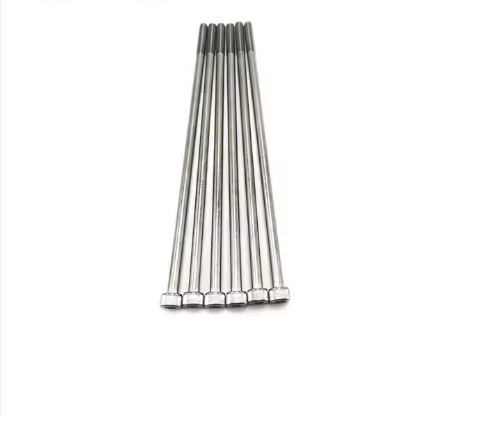Release time:2020-01-16 18:44 Browse:

### 1. **Material Foundation: Carbon Steel** - **Composition and General Traits**:These screws are crafted from carbon steel, a widely - used material in the fastener industry. Carbon steel offers a good balance of strength, formability, and cost - effectiveness. The carbon content in the steel, typically in the medium - carbon range for 8.8 - grade applications, contributes significantly to its mechanical properties. As the carbon content increases, the steel becomes stronger and harder, but its ductility may decrease slightly. This medium - carbon steel is carefully selected to meet the requirements of the 8.8 - grade classification, ensuring that the screws can withstand substantial loads. - **Heat Treatment Influence**:To achieve the 8.8 - grade strength, the carbon steel undergoes a specific heat treatment process. Quenching and tempering are the common heat treatment methods applied. During quenching, the steel is rapidly cooled from a high temperature, which increases its hardness and strength. Subsequently, tempering is carried out to relieve the internal stresses induced by quenching and to adjust the toughness of the steel. This heat treatment combination optimizes the mechanical properties of the carbon steel, making it suitable for applications where both strength and a certain level of toughness are required, such as in machinery and automotive industries. ### 2. **Strength Grade: 8.8** - **Tensile and Yield Strength Specifications**:An 8.8 - grade screw has a minimum tensile strength of 800 MPa and a minimum yield strength of 640 MPa. These strength values are crucial in determining the screw's load - bearing capacity. In practical applications, when these screws are used to fasten components together, they need to withstand the forces exerted on the joint, such as tensile forces that try to pull the components apart and shear forces that act parallel to the cross - section of the screw. The 8.8 - grade strength ensures that the screw can maintain the integrity of the connection under significant loads, providing reliable fastening in various industrial scenarios. - **Application Suitability**:Due to their medium - high strength level, 8.8 - grade screws are widely used in general non - preloaded structural applications. They are suitable for use in machinery manufacturing, where they can be used to assemble different parts of machines, such as fastening gears, pulleys, and shafts. In the automotive industry, they are used in engine assemblies, chassis components, and other areas where a reliable and strong fastening solution is required. However, it should be noted that according to the European standard related to 8.8 - grade fasteners (such as EN 15048), these screws are not typically intended for welding operations, as welding can affect their mechanical properties and the integrity of the joint. ### 3. **Standard Compliance: DIN912** - **Origin and Significance of DIN912**:DIN912 is a standard developed by the Deutsches Institut für Normung (DIN), the German Institute for Standardization. This standard is highly regarded and widely adopted not only in Germany but also across Europe and in many international markets. It precisely defines the dimensions, tolerances, and performance requirements for hexagon socket head cap screws. By adhering to DIN912, manufacturers ensure that their products are consistent in quality and can be easily interchanged with other DIN912 - compliant components. This is of great importance in large - scale industrial projects where components from multiple suppliers need to work together seamlessly. - **Specific Dimensions and Tolerances**:DIN912 covers a wide range of sizes. The thread diameter of these screws typically ranges from as small as M1.6 to as large as M64 in Grade A metric products. The thread tolerance for most grades is set at 6g, except for the 12.9 grade, which has a more precise 5g6g tolerance. The head height, diameter, and the dimensions of the internal hexagonal socket are also clearly specified. For example, the head diameter is designed to provide an appropriate bearing surface area when the screw is tightened, and the socket dimensions are standardized to ensure a proper fit with hex keys or Allen wrenches, allowing for efficient torque application. ### 4. **Design Features** - **Semi - Threaded Structure**:These screws are semi - threaded, which means that only part of the shank is threaded. The threaded section is designed to engage with nuts or threaded holes, providing a secure connection. The unthreaded part of the shank, on the other hand, has several advantages. In applications where the screw is subjected to shear forces, such as when fastening two plates together that may experience relative movement in a direction parallel to the screw axis, the unthreaded shank offers better shear resistance compared to a fully - threaded screw. The unthreaded shank also allows for a more even distribution of stress along the length of the screw, reducing the risk of stress concentration at the thread roots. - **Long - Shank Design**:The long - shank feature of these screws makes them suitable for applications where the screw needs to pass through thick materials or multiple layers of components. For instance, in the construction of heavy machinery, where large - scale brackets and panels need to be fastened together, the long - shank screws can reach through the various layers and provide a secure connection. The length of the shank is carefully designed to ensure that there is sufficient thread engagement at the fastening point while also allowing for proper installation and adjustment. - **Knurled Finish on the Head**:The knurled finish on the hexagonal socket head of the screw serves an important function. Knurling consists of a series of small, raised ridges on the surface of the head. This textured surface significantly improves the grip when using a hex key or Allen wrench to tighten or loosen the screw. In industrial environments where high torque may be required to install or remove the screw, the knurled finish prevents the wrench from slipping, ensuring a more secure and efficient operation. It also provides better control during the installation process, reducing the risk of damaging the screw or the components being fastened. ### 5. **Surface Treatment: Galvanized** - **Corrosion - Resistance Mechanism**:The galvanized coating on these screws is primarily used to enhance their corrosion resistance. Galvanization involves applying a layer of zinc to the surface of the carbon steel. Zinc is more reactive than iron (the main component of carbon steel), so when the galvanized screw is exposed to the environment, the zinc acts as a sacrificial anode. In the presence of moisture and oxygen, the zinc corrodes preferentially, protecting the underlying steel from rusting. This sacrificial protection mechanism is highly effective in preventing the formation of rust and extending the lifespan of the screw, especially in outdoor or humid environments. - **Types of Galvanization**:There are two main types of galvanization processes that can be applied to these screws: electro - galvanizing (also known as cold - galvanizing) and hot - dip galvanizing. Electro - galvanizing involves depositing a thin layer of zinc onto the surface of the screw through an electrochemical process. This method provides a relatively smooth and uniform coating, which is suitable for applications where a more aesthetically pleasing finish is required, and the corrosion resistance requirements are not extremely high. Hot - dip galvanizing, on the other hand, involves dipping the screw into a bath of molten zinc. This process results in a thicker and more robust zinc coating, offering superior corrosion resistance. Hot - dip galvanized screws are often used in harsh environments, such as in construction projects where the screws may be exposed to rain, snow, and other weather elements for long periods.

